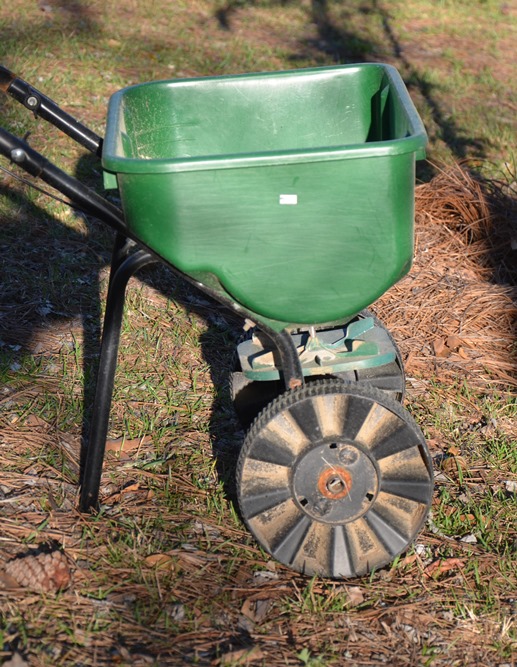
by Les Harrison | Jun 15, 2017
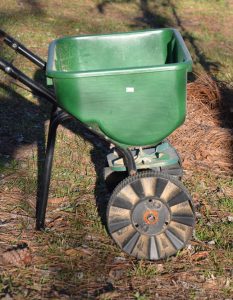
Fertilizer spreader use is in full swing throughout the Florida panhandle
Fertilizing a lawn properly in the summer can enhance the landscape without inducing disease or harming the environment .
One universal activity is seasonal lawn and landscape maintenance. While some consider it a chore, many view it as a means to enhancing their personal environment.
The list of tasks are, for the most part, standard with few surprises. Raking leaves and pine straw, replacing shrubs which did not make it through the winter, and fertilizing the lawn and landscape.
While a routine undertaking, applying fertilizer requires thought and consideration to be effective without negative consequences. It should be a deliberate and well-planned accomplishment which is science based.
The proper selection of a fertilizer should be based on a soil test. Every UF/IFAS Extension Office has supplies for pulling and submitting a soil sample for evaluation.
The results, which can come via mail or e-mail, will tell the homeowner what nutritional deficiencies exist in their lawn and landscape. Based on the type of grass or shrubs, the report will deliver the information on the fertilizer analysis needed for optimum plant performance.
With this information in hand, the homeowner can visit a local retailer who can provide the product which meets the needs of the landscape without wasting excess nutrients. Excess soil nutrients can easily be relocated to bodies of water when storm water washes it downstream.
Homeowners have several types of fertilize from which to choose for use on their lawn. Each has distinct advantages and disadvantages.
Dry blend fertilizer is usually the least expensive and is easy to find in the market place. It is a mixture of minerals and compounds which are combined to produce a particular analysis, such as 10-10-10.
This analysis is ten percent nitrogen, ten percent phosphorus, and ten percent potassium with the remaining 70 percent being micronutrients and inert carrier. Applied correctly, it can be effective at delivering the needed nutrients.
It is most effective when applied several times throughout the growing season. The grass and shrubs will then have a continuous supply of the needed nutrients over time.
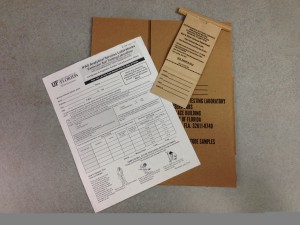
Soil test kit available from your local Extension office. Photo: Mary Derrick, UF/IFAS.
One potential problem with dry blend fertilizer is the particle size of the different nutrients. If irregular, they can separate during transportation to the retailer.
This can be easily corrected by the homeowner. Just pour the contents of the bag into a container and mix using a can or shovel.
Dry slow-release fertilizers are gaining popularity, but they are more expensive. They have a sulfur or polymer coating on the particles which allows for the slow release of the nutrients.
A single application can last for up to six months which frees the homeowner to pursue other activities. The most common use of this product is with shrubs and potted plants.
Liquid fertilizer concentrates are available, but the convenience comes at a high cost. It is easily diluted for use, but uniform application over a large area can be challenging.
No matter which form is used, proper application will grow good results. A healthy and well maintained lawn and landscape leave more time for other springtime pursuits.
To learn more about the fertilizer for your landscape, contact your county agent and refer to this section on our website devoted to lawn fertilization.
by Matt Lollar | Apr 13, 2017
Most of you plant a spring vegetable garden with a number of different vegetable types. However, you may not realize that you are improving the health of your soil and your crops by planting a diverse garden. Intercropping is a gardening practice of growing different crops in the same field. When planting a mixture of crops in the same field year after year, it is important to rotate the location of each type of vegetable. This is a practice known as crop rotation. Intercropping and crop rotation will help reduce insect pest populations, increase beneficial insect populations, and reduce weed populations.
Crop Diversity
Growing plants in your garden that pest insects don’t like to eat makes the pests work harder to find what they do like to eat. Studies have found reduced whitefly numbers on squash plantings mixed with a crop of buckwheat when compared to squash planted alone. Another crop mixture that may be unintentional, but may work in your favor is a row of crapemyrtles along the edge of your garden. Crapemyrtles will attract the crapemyrtle aphid which will attract predatory insects. When the predatory insects run out of crapemyrtle aphids to eat, they will move to your garden and begin to hunt pest insects on your vegetable crop.
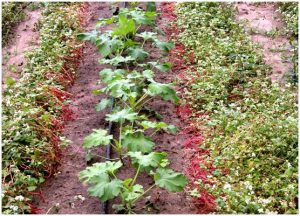
Squash with living mulch of buckwheat. Photo Credit: Oscar Liburd, UF/IFAS Extension
Trap Cropping
A trap crop is a plant that attracts a pest insect away from your food crops. Trap crops work best when planted at the edge of your garden, along a fence row, or in movable containers. A bare space, let’s say 5 feet or so, should be kept between your trap crop and your garden. This will help keep the pests from moving on to your vegetables. When you find a good population of pests on your trap crop then it is time to spray them with insecticide or cut the crop down and remove the debris to a location far from your garden. If your trap crops are planted in containers, then it makes them that much easier to remove from near the garden area.
Cover Crops and Green Manure
Soil organic matter can be increased by the use of green manure and cover crops. Cover crops are generally planted during the off-season, but they can be planted in between vegetable rows and tilled in at a designated time as a green manure. Both cover crops and green manure improve the production of your garden by:
- Suppressing weeds by competing for water, light, and nutrients;
- Holding the soil in place and preventing erosion;
- Scavenging for nutrients that can be utilized in future crops;
- Reducing nematode populations;
- Providing a habitat for beneficial insects.
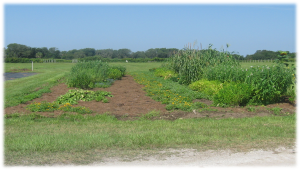
A mixed plot of cover crops and trap crops. Photo Credit: UF/IFAS Extension
A number of different crops can serve as cover crops or green manure crops. Most are legumes (bean family) or grasses. A few that you might like to give a try are:
- Cowpeas
- Sunn hemp
- Sorghum-sudangrass
- Winter rye
More detailed information on cover crops and green manure can be found at this link: http://edis.ifas.ufl.edu/aa217.

by Ray Bodrey | Aug 19, 2016
Being a gardener in the panhandle has its advantages. We’re able to grow a tremendous variety of vegetables on a year-round basis. However, in this climate, plant diseases, insects and weeds can often thrive. Usually, chemical measures are applied to thwart these pests. Some panhandle gardeners are now searching for techniques regarding a more natural form of gardening, known as organic. With fall garden planting just ahead, this may be an option for conventional vegetable gardeners looking for a challenge.
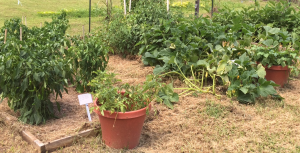
Vegetable Garden at UF/IFAS Extension Wakulla County. Photo credit: Ray Bodrey UF/IFAS.
So, what is organic gardening? Well, that really depends on who you ask. A broad definition is gardening without the use of synthesized fertilizers and industrial pesticides. Fair warning, “organic” does not translate into easier physical gardening methods. Laborious weeding and amending of soil are big parts of this gardening philosophy. This begs the question, why give up these proven industrial nutrient and pest control practices? Answer: organic gardening enthusiasts are extremely health conscious with the belief that vigorous outdoor activity coupled with food free of industrial chemicals will lead to better nutrition and health.
As stated earlier, the main difference between conventional and organic gardening is the methods used in fertilization and pest control. In either gardening style, be sure to select a garden plot with well-drained soil, as this is key for any vegetable crop. Soil preparation is the most important step in the process. To have a successful organic operation, the garden will require abundant quantities of organic material, usually in the form of animal manures and compost or mixed organic fertilizer. These materials will ensure water and nutrient holding capacity. Organic matter also supports microbiological activity in the soil. This contributes additional nutrients for plant uptake. Organic fertilizers and conditioners work very slowly. The vegetable garden soil will need to be mixed and prepped at least three weeks ahead of planting.
Effective organic pest management begins with observing the correct planting times, selection of the proper plant variety and water scheduling. Selecting vegetable varieties with pest resistant characteristics should be considered. Crop rotation is also a must. Members of the same crop family should not be planted repeatedly in the same organic garden soil. Over watering can be an issue. Avoid soils from becoming too wet and water only during daylight hours.
For weed management, using hand tools to physically removing weeds is the only control method. As for insect management, planting native plants in the immediate landscape of the organic garden will help draw in beneficial insects that will feast on garden insect pests. The use of horticultural oil or neem oil is useful. However, please read the product label. Some brands of oils are not necessarily “organic”. Nematodes, which are microscopic worms that attack plant roots, are less likely an issue in organic gardens. High levels of organic matter in soil causes an inhospitable environment for nematodes. Organic disease management unfortunately offers little to no controls. Sanitation, planting resistant varieties and crop rotation are the only defense mechanisms. Sanitation refers to avoiding the introduction of potential diseased transplants. Disinfecting gardens tools will also help. Hydrogen peroxide, chlorine and household bleach are disinfecting chemicals allowed in organic gardening settings as these chemicals are used in organic production systems for sanitation. Staking and mulching are also ways to keep plants from diseases by avoiding contact with each other and the soil.
Organic gardening can be a challenge to manage, but better health and nutrition could be the reward. Please take the article recommendations into consideration when deciding on whether to plant an organic garden. For more information, contact your local county extension office.
Supporting information for this article can be found in the UF/IFAS EDIS publication, Organic Vegetable Gardening in Florida, by Danielle D. Treadwell, Sydney Park Brown, James Stephens, and Susan Webb.
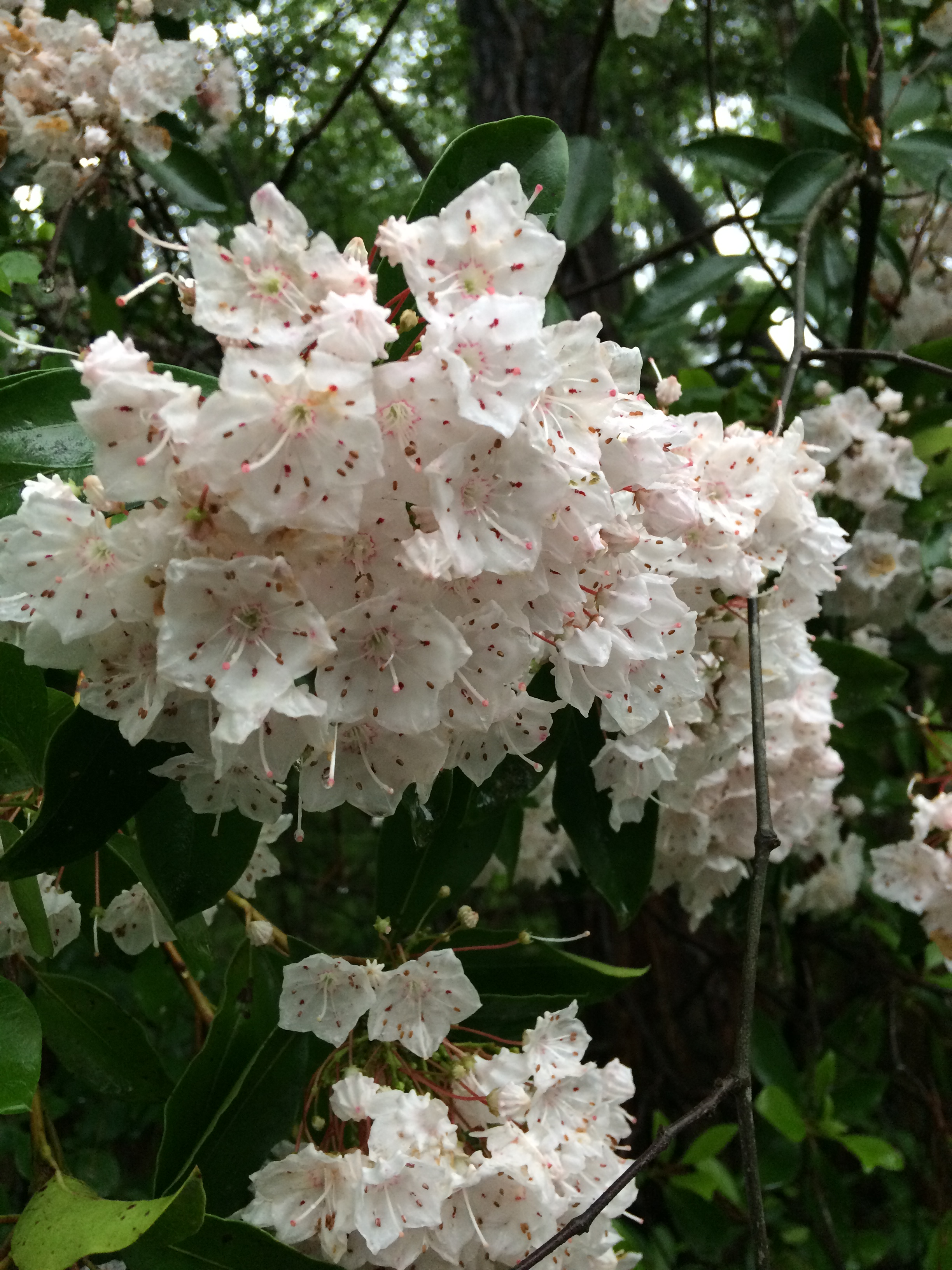
by Sheila Dunning | Apr 21, 2016
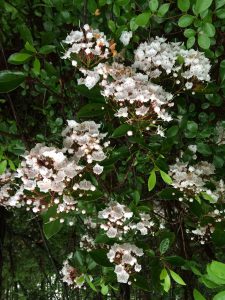
Mountain laurel. Photo credit: Sheila Dunning, UF/IFAS Extension.
If you are lucky enough to live on the southern Alabama edge of northwest Florida, you may want to see if you can find mountain laurel blooming now near the wooded creeks. Its native range stretches from southern Maine south to northern Florida, just dipping into our area. The plant is naturally found on rocky slopes and mountainous forest areas. Both are nearly impossible to find in Florida. However, it thrives in acidic soil, preferring a soil pH of 4.5 to 5.5 and oak-healthy forests. That is something we do have. The challenge is to find a cool slope near spring-fed water.
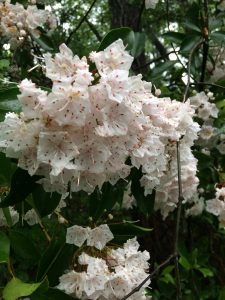
Mountain laurel blooms. Photo credit: Sheila Dunning, UF/IFAS Extension.
Mountain laurel (Kalmia latifolia) was first recorded in America in 1624, but it was named after Pehr Kalm, who had collected and submitted samples to Linnaeus in the 18th century. The wood of mountain laurel was popular for small household items. It is heavy and strong with a close, straight grain. However, as it grow larger it becomes brittle. Native Americans used the leaves as an analgesic. But, all parts of the plant are toxic to horses, goats, cattle, deer, monkeys and humans. In fact, food products made from it, including honey, can produce neurotoxic and gastrointestinal symptoms in people consuming more than a modest amount. Luckily, the honey is usually so bitter that most will avoid eating it.
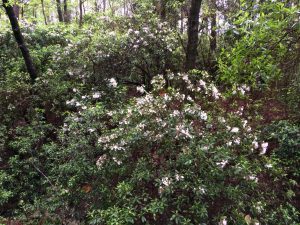
Mountain laurel in its native habitat. Photo credit: Sheila Dunning, UF/IFAS Extension.
One of the most unusual characteristics of mountain laurel is its unique method of dispersing pollen. As the flower grows, the filaments of its stamens are bent, creating tension. When an insect lands on the flower, the tension is released, catapulting the pollen forcefully onto the insect. Scientific experiments on the flower have demonstrated it ability to fling the pollen over 1/2 inch. I guess if you don’t taste that good, you have to find a way to force the bees to take pollen with them.
The mountain laurel in these pictures is from Poverty Creek, a small creek near our office in Crestview. This is their best bloom in 10 years. Maybe you can find some too.
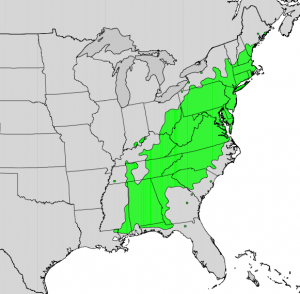
Native range of mountain laurel.
by Larry Williams | Oct 6, 2015
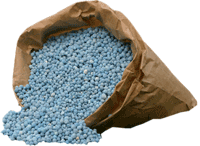
Fertilizer: Image Credit UF / IFAS
In Northwest Florida, all of our lawn grasses begin to fade and slowdown in growth during fall.They are supposed to go dormant. Some will go dormant earlier than others based on species, location and management.
The grasses we use to create lawns are warm season grasses such as centipedegrass, St. augustinegrass, bahiagrass, bermudagrass and zoysiagrass.
The cooler temperatures (particularly cooler night temperatures) and the shorter days of autumn trigger these grasses to slow down. Their color begins to fade and eventually they turn brown, usually after a frost or freeze.
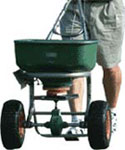
Fertilizer Spreader: Image Credit UF / IFAS
As these warm season grasses go dormant, they don’t need to be fertilized, particularly with a high nitrogen fertilizer. Some of the so called “winterizer” fertilizers available in our area can cause more damage than good despite the advertisements.
Nitrogen encourages new growth and interferes with the dormancy process, forcing the lawn to produce new tender growth at the wrong time of year. This sets the lawn up for damage. That young tender growth is very susceptible to cold injury and is likely to be damaged by the first frost. This greatly weakens the lawn and many times the damage goes unnoticed until the following spring when sections of the lawn do not green up. If you insist on “winterizing” your lawn, use a fertilizer with low nitrogen (represented by the first number in the fertilizer analysis) and high potassium (represented by the last number in the analysis). In most cases the center number (phosphorus) should also be low. But never use a high nitrogen fertilizer late in the season.
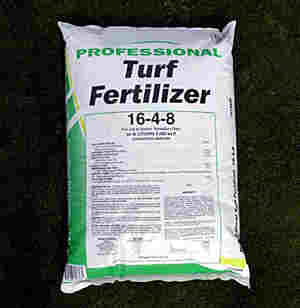
Fertilizer: Image Credit UF / IFAS
Large patch disease is another reason to avoid fertilizing after September, particularly with a high nitrogen fertilizer. Too much nitrogen at the wrong time promotes a common lawn disease called large patch, formerly known as brown patch. This disease is caused by the fungus Rhizoctonia. Large patch functions as a pathogen in our lawns during the cooler weather of fall and spring. Applying a high nitrogen fertilizer when large patch is active can be like applying gasoline to a fire, allowing this lawn disease to rage out of control.
In order for the fertilizer to do any good at all for the lawn, it needs to be applied while the grass is actively growing, when the grass can readily take it in. After the lawn is dormant and when the soil temperature is cooler, much of the fertilizer that could have benefited the grass is wasted.















